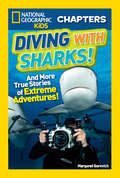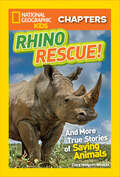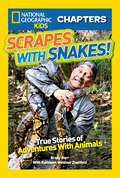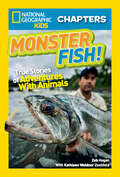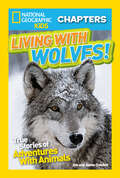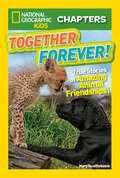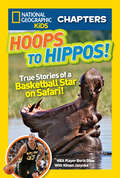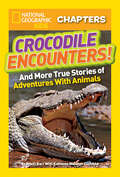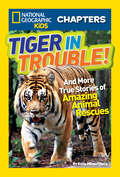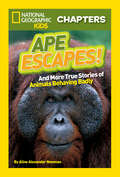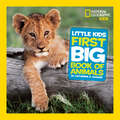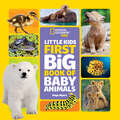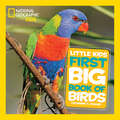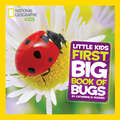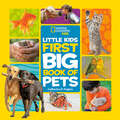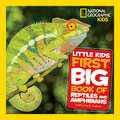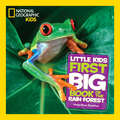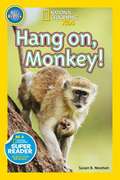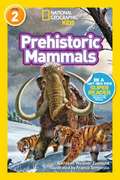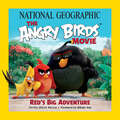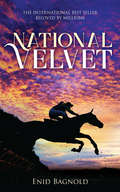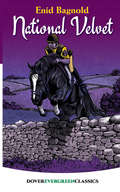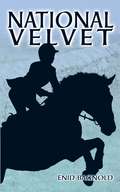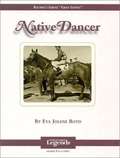- Table View
- List View
National Geographic Kids Chapters: And More True Stories of Extreme Adventures! (NGK Chapters)
by Margaret GurevichFans of Shark Week, Sharknado, and all things shark-related will want to sink their teeth into this exciting shark-infested chapter book. Join real-life cave divers, extreme photographers, and researchers as they brave thrilling undersea adventures! Kids who are familiar with the popular National Geographic Kids Chapters line are sure to be on the edge of their seats over these new totally true tales of adventure and survival.
National Geographic Kids Chapters: And More True Stories of Saving Animals (NGK Chapters)
by Clare Hodgson MeekerWhat happens when conservationists meet rhinos in trouble? They arrange to airlift them to safety! Follow National Geographic Explorers-in-Residence Dereck and Beverly Joubert as they move rhinos out of harm's way, meet a courageous little Hawaiian monk seal, and a pair of Siberian tiger cubs fighting for survival. Readers will cheer as they read these completely true stories of animal rescues. Filled with engaging photos, fast facts, and fascinating sidebars, readers won't want to put this book down.
National Geographic Kids Chapters: True Stories of Adventures With Animals (NGK Chapters)
by Kathleen Weidner Zoehfeld Brady BarrJoin National Geographic expert and TV personality Brady Barr on some wild adventures with snakes! Readers won't believe their eyes as they read Barr's hilarious—and completely true!—accounts of his interactions with some of the biggest, weirdest, and craziest snakes on Earth. Filled with engaging photos, fast facts, and fascinating sidebars, readers won't want to put this book down.
National Geographic Kids Chapters: True Stories of Adventures With Animals (NGK Chapters)
by Kathleen Weidner Zoehfeld Zeb HoganFor Zeb Hogan, bigger is better – especially when it comes to fish. From sawfish to alligator gars to giant stingrays, Zeb's on a mission to save the world's freshwater giants. In this cool Chapter book, you'll join Zeb on amazing – and TRUE – adventures with supersize swimmers.
National Geographic Kids Chapters: True Stories of Adventures With Animals (NGK Chapters) (NGK Chapters)
by Jamie Dutcher Jim DutcherImagine living with a pack of wolves! For National Geographic wildlife documentarians Jim and Jamie Dutcher, that dream came true. Join the Dutchers as they discover what life is like among wolves in the western wilderness. Filled with engaging photos, fast facts, and fascinating sidebars, readers will be howling for more.
National Geographic Kids Chapters: True Stories of Amazing Animal Friendships! (NGK Chapters)
by Mary QuattlebaumA fluffy chicken and a pup on wheels? A goat and a donkey who are inseparable? Puppy and cheetah best friends? This new chapter book features all kinds of heartwarming, awwwww-inspiring—and completely true—stories about animal friendships. It's so funny, sweet, and filled with engaging photos, fast facts, and fascinating sidebars, that you can't help but want to cuddle up and read about these unlikely pairings and animal best buddies.
National Geographic Kids Chapters: True Stories of a Basketball Star on Safari (NGK Chapters)
by Kitson JazynkaNBA star Boris Diaw of the San Antonio Spurs takes young readers on safari as he explores his off-court passion: wildlife photography! Join Diaw as he escapes from stampeding wildebeests, comes face-to-face with lions, and discovers why you should never come between a hippo and its watery home. Through engaging stories and photos by Diaw, readers will discover a whole new side to this basketball champ. National Geographic Kids Chapter books pick up where the best-selling National Geographic Readers series leaves off, offering young animal lovers who are ready for short chapters lively, exciting, full-color true stories—just right to carry in backpacks, share with friends, and read under the covers at night.
National Geographic Kids Chapters: and More True Stories of Adventures with Animals (NGK Chapters)
by Kathleen Weidner Zoehfeld Brady BarrThe first in a line of adventures within the National Geographic Kids Chapters series, Crocodile Encounters will surely prove to be one of the most exciting. Follow along with National Geographic explorer Brady Barr as he crawls into a muddy hole just barely big enough for his shoulders, and comes face to face with thirteen crocodiles! Laugh out loud as you learn how to catch a crocodile using shoe laces and underpants. Read in anticipation to find out what happens when you put a 600-lb crocodile on an airplane in just a flimsy wooden crate. These action-packed stories and more will engage readers and inspire them to go out and explore their own world.Stories include: • "Undercover Croc," in which Brady "becomes a crocodile," by donning a specially-designed protective croc suit, and infiltrates a group of Nile crocodiles in Tanzania. • "Toy Story," in which he uses (and loses) a radio-controlled car with video camera, in a hilarious failed attempt to capture a Nile crocodile in South Africa. • "Deep Dark Den"--in an attempt to relocate a group of crocodiles causing problems to neighboring villagers in Costa Rica, Brady finds himself underground in a deep muddy hole with thirteen angry crocs. • "Croc in a Box," Brady tries to move a giant, troublesome croc from Uganda safely to an American zoo, but discovers the croc is much stronger than the "sturdy wooden box" that has been built to contain him. National Geographic supports K-12 educators with ELA Common Core Resources.Visit www.natgeoed.org/commoncore for more information.Releases simultaneously in Reinforced Library Binding: 978-1-4263-1029-4 , $14.90/$16.95 CanE-book: 978-1-4263-1030-0 , $5.99/$5.99 Can
National Geographic Kids Chapters: and More True Stories of Amazing Animal Rescues (NGK Chapters)
by Kelly Milner HallsFollow the journey of Nitro, a tiger kept in captivity in Kansas. His story starts when the county sheriffs visited a Kansas property and decided to confiscate all big cats from their owner. Lions were sent to the Detroit Zoo, and Nitro and his friend Apache went to the Carolina Tiger Rescue. As Nitro was adjusting to his new home, things went terribly wrong. Fever broke out, and he lost his sight. With the help of his rescuers, his friend Apache, and a lot of patience and love, blind Nitro was given a whole new way to "see". Nitro became the keepers' and visitors' favorite. Filled with gorgeous photographs, sidebars, and fun facts, Tiger in Trouble! is sure to captivate all big cats lovers. Kids will learn great tips about these fascinating creatures and how to contribute to their conservation.Stories in this books also include: • Ethereal's survival story: the white albino bat • Susie, Bob, and Caleb: The Three MonkeyteersThis book will capture the hearts of animal lovers everywhere, as they will love reading the true stories of humans saving the lives of amazing animals.Releases simultaneously in Reinforced Library Binding: 978-1-4263-1079-9 , $14.90/$16.95 CanE-book: 978-1-4263-1080-5 , $5.99/$5.99 CanNational Geographic supports K-12 educators with ELA Common Core Resources.Visit www.natgeoed.org/commoncore for more information.
National Geographic Kids Chapters: and More True Stories of Animals Behaving Badly (NGK Chapters)
by Aline Alexander NewmanThis is the first in a series of 4 books that will tell the true and hilarious stories of animals that love hijinks. In this book you'll meet 3 naughty animals, including Fu Manchu, the orangutan escape artist. Fu Manchu lived at the Omaha Zoo and would routinely break out of his habitat to explore the zoo on a nice day. Zookeepers were baffled as to how the ape was escaping, until one day they caught him in the act. Fu Manchu knew how to pick locks. Not only that, he had created his own tool that he used to pick the locks with, which he would store in his mouth so as not to be found out. This and two other charming stories will engage readers and leave them wondering if humans are really the smartest animals.
National Geographic Little Kids First Big Book of Animals (National Geographic Little Kids First Big Books)
by Catherine D. HughesThe National Geographic Little Kids First Big Book of Animals is an adorable animal reference sure to be welcomed by parents and librarians alike. Filled with fluffy and scaly creatures big and small, this appealing book introduces the youngest explorers to the world of wildlife, using a child-friendly format inspired by the blockbuster National Geographic Little Kids magazine. This exciting new reference for the very young mirrors the magazine&’s square shape, readable fonts, and fun content, to keep little ones thrilled with every colorful page.Little Kids First Big Book of Animals devotes four pages each to 32 high-interest creatures, including dolphins, tigers, butterflies, frogs, penguins, wolves, and pandas. More than 150 of National Geographic&’s most charming animal photos illustrate the profiles, which feature just the kind of facts that little kids want to know—the creature&’s size, diet, home, and more.Child-friendly text explains how animal parents take care of their young, how baby animals change as they grow, and how they learn to hunt and eat. The brief text, large type, and appealing profiles are perfect for young readers to enjoy on their own, or for parents and other caregivers to read aloud. These animal tales will quickly become favorites at storytime, bedtime, and any other time.
National Geographic Little Kids First Big Book of Baby Animals (National Geographic Little Kids First Big Books)
by Maya MyersThis may be the cutest Little Kids First Big Book ever! From panda cubs and prairie dog pups to beluga calves and fuzzy flamingo chicks, this book is packed with fascinating information about adorable and aww- some baby animals. Meet more than 40 animal babies from every corner of the globe, from ocean depths to mountaintops, grassy plains to polar lands. Features include: A map that shows where these animals are found in the wild Questions in each chapter that encourage interactive learning Simple text for reading aloud or for beginning readers Engaging photography of real animals in their habitats Parent tips that extend the experience beyond the book Find out how these wee wild ones are born, where they live, what their families are like, how they get their food, and how they learn to do things on their own—all the things that are important to young humans, too! Complete your collection with these popular titles from the best-selling National Geographic Little Kids First Big Book series: Little Kids First Big Book of Animals Little Kids First Big Book of the Ocean Little Kids First Big Book of Reptiles and Amphibians Little Kids First Big Book of Birds Little Kids First Big Book of Bugs Little Kids First Big Book of the Rain Forest Little Kids First Big Book of Pets
National Geographic Little Kids First Big Book of Birds (National Geographic Little Kids First Big Books)
by Catherine D. HughesThis adorable reference introduces young readers to birds of all kinds: big and small, flyers and swimmers, colorful and plain. They&’ll find backyard favorites, such as robins and cardinals and be introduced to more unique species that inhabit rain forests and deserts around the world. Bird behaviors kids can relate to, including singing, dancing, building, swimming, and diving, reveal fascinating insights into the avian world. More than 100 colorful photos are paired with profiles of each bird, along with facts about the creatures' sizes, diets, homes, and more. This charming book will quickly become a favorite at storytime, bedtime, and any other time.
National Geographic Little Kids First Big Book of Bugs (National Geographic Little Kids First Big Books)
by Catherine D. HughesThe experts at National Geographic present a delightful reference that introduces young children to bugs of all kinds: big and small, jumping and crawling, colorful and creepy. This charming book explores backyard favorites, such as ladybugs and lightning bugs, and introduces kids to more exotic species that inhabit rain forests and deserts around the world. Colorful photos are paired with profiles of each insect, along with facts about the creatures' sizes, diets, homes, and more. This book will quickly become a favorite at storytime, bedtime, and any other time!
National Geographic Little Kids First Big Book of Pets (National Geographic Little Kids First Big Books)
by Catherine D. HughesPlayful puppies! Cuddly kittens! Beautiful birds! In the next book in the hit Little Kids First Big Book series, readers learn all about pets with fur, feathers, fins, scales, and shells--and how to find and care for the perfect pet for their family.From cats to dogs to guinea pigs to birds to fish to snakes and more, this adorable reference book introduces kids to a wide variety of family-friendly pets. Readers learn which kinds of animals make good pets and which ones are better off staying in the wild, along with how each type of pet eats, sleeps, and plays. Packed with more than 200 colorful photos, the book also provides information on animal breeds, characteristics, and behavior and includes tips for training pets. Filled with fun facts and designed for interactive learning, this book will quickly become a favorite at storytime, bedtime, and any time.
National Geographic Little Kids First Big Book of Reptiles and Amphibians
by Catherine D. HughesThis addition to the hit Little Kids First Big Book series explores the fascinating world of reptiles and amphibians, from slithering snakes and scaly lizards to bumpy frogs and spotty salamanders.Get ready to meet a variety of awesome animals, from frilled lizards to giant tortoises to goliath frogs. This reference book for the younger set answers questions that range from "What is the biggest reptile in the world?" to "How can a boa constrictor fit a deer into its mouth?" Readers explore what makes an animal a reptile or an amphibian and learn about more than 45 different creatures. Packed with more than 250 stunning color photos, the book also provides information on animal habitats, characteristics, and behavior. Filled with fun facts and designed for interactive learning, it is sure to become a favorite with budding herpetologists and their parents.
National Geographic Little Kids First Big Book of the Rain Forest (National Geographic Little Kids First Big Books)
by Moira Rose DonohueColoful birds! Jaguars! Tree frogs! National Geographic presents a delightful, age-appropriate introduction to tropical rain forest creatures big and small in this new title in the popular Little Kids First Big Book series.This adorable animal book about all things jungle features favorite animals found in tropical rain forests. Readers meet jaguars prowling the forest floor, snakes slithering through the understory, red-eyed tree frogs leaping through the canopy, butterflies flitting through the tallest treetops, and many other creatures that inhabit all the different layers. More than 200 charming animal photos illustrate the profiles, with facts about the creatures' sizes, diets, homes, and more. A map of tropical rain forests around the world shows where the animals in the book are found, and the book also introduces readers to plant life. This book will quickly become a favorite at storytime, bedtime, and any time.
National Geographic Readers: Hang On, Monkey!
by Susan B. NeumanHang On, Monkey! uses simple vocabulary and fun pictures to capture the interest and help develop the skills of beginning readers. The crazy antics, humor, and fun information make this new reading experience a treat.
National Geographic Readers: Prehistoric Mammals (Readers Ser.)
by Franco Tempesta Kathleen ZoehfeldFrom woolly mammoths to saber-toothed cats, prehistoric mammals once roamed Earth. With beautiful and engaging illustrations, authentic photos, and accessible text, kids will learn all about these mighty mammals in this Level 2 reader.
National Geographic The Angry Birds Movie: Red's Big Adventure
by Christy Ullrich BarcusThis latest entry in the National Geographic Angry Birds series will take you on an amazing journey with Red, the leader of the Angry Birds flock, along with Matilda, Chuck, Bomb, Terence, and the mysterious Mighty Eagle. Featuring The Angry Birds Movie (2016) story world, this book is filled with all the fun facts and information Red and the flock need to embark on their big adventure. From identifying wildlife to navigating by the stars to building a shelter and setting traps (for any roaming Piggies), this book will be sure to educate and entertain.
National Velvet (Dover Children's Evergreen Classics Ser.)
by Enid Bagnold"Put on your not-to-be-missed list." — The New YorkerHer mother calls it "a breathtaking piece of folly," but fourteen-year-old Velvet Brown is determined: every night she prays to be the best rider in England, and every day she trains to win the world's most famous steeplechase, the Grand National. No woman has ever competed in the race, let alone won it. Velvet is skinny and frail, and her mount is a rough country horse that she won in a raffle. But she whispers her hopes and dreams into his ear, and the horse flies over fences at her command.Generations of readers of all ages have thrilled to the tale of Velvet's grit and determination and its inspiring example of the struggles and rewards of following a dream. A richly atmospheric portrait of rural life between the World Wars, National Velvet was a selection of the Book-of-the-Month Club in the United States and the Book Society in England upon its 1935 debut. It also served as the basis for the popular movie starring Elizabeth Taylor and Mickey Rooney. This charming new edition features the original drawings by Laurion Jones, the author's thirteen-year-old daughter."The book is one that horse lovers of every age cannot fail to enjoy." — The New York Times"Humorous, charming, National Velvet is a little masterpiece." — Time"This book deserves a top place on your shelf." — Christian Science Monitor
National Velvet (Dover Children's Evergreen Classics)
by Enid Bagnold"The book is one that horse lovers of every age cannot fail to enjoy." — The New York Times "Humorous, charming, National Velvet is a little masterpiece." — Time "Put on your not-to-be-missed list." — The New Yorker A butcher's daughter in a small Sussex town ends her nightly prayers with "Oh, God, give me horses, give me horses! Let me be the best rider in England!" The answer to fourteen-year-old Velvet Brown's plea materializes in the form of an unwanted piebald, raffled off in a village lottery, who turns out to be adept at jumping fences—exactly the sort of horse that could win the world's most famous steeplechase, the Grand National. Richly atmospheric of rural English life between the World Wars, National Velvet has enchanted generations of readers since its 1935 debut. The heroine's grit and determination, backed by the support of her eccentric and loving family, offer an inspiring example of the struggles and rewards of following a dream.
National Velvet (Egmont Modern Classics)
by Enid BagnoldFourteen-year-old Velvet Brown is obsessed with horses. When she prays for horses, her prayer is answered - a village neighbor wills her five ponies, and then she wins the wild and beautiful Piebald in a raffle. Velvet's mother, who once swam the English Channel, has raised her to believe in herself. When she realizes that the Piebald is a remarkable jumper Velvet decides to enter him in the Grand National, the most prestigious steeplechase in Britain. With the help of her father's assistant, Mi Taylor, Velvet disguises herself as a boy and rides The Piebald in the race.
National Worm Day
by James StevensonRupert is a rhinoceros who meets up with some other animals who are not very kind to him. Then he finds two animals who turn out to be good friends.
Native Dancer (Thoroughbred Legends #7)
by Eva Jolene BoydKnown as "The Gray Ghost" because of his color and his amazing ability on the racetrack, Native Dancer won all but one of his 22 starts. His lone loss came in the 1953 Kentucky Derby, when he was upset by Dark Star. Native Dancer went on to win the Preakness and Belmont Stakes. But his brilliance was evident even at two, when he won all nine of his starts and was named co-Horse of the Year, an honor not bestowed on a two-year-old horse again until 20 years later, when Secretariat was named Horse of the Year in 1972.
